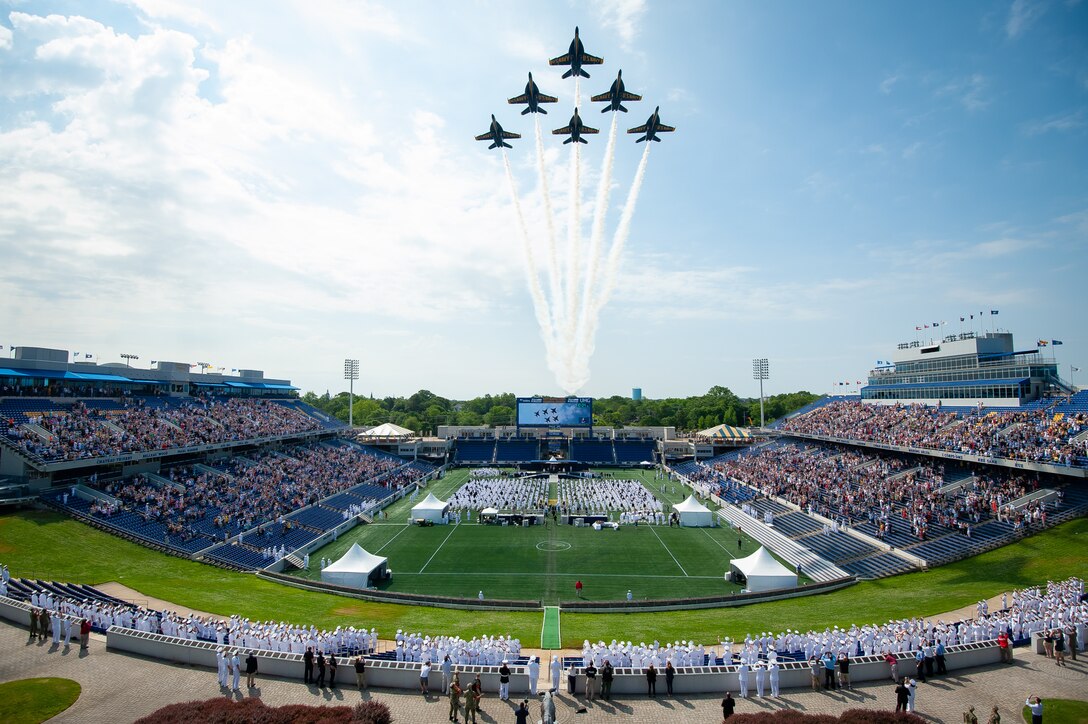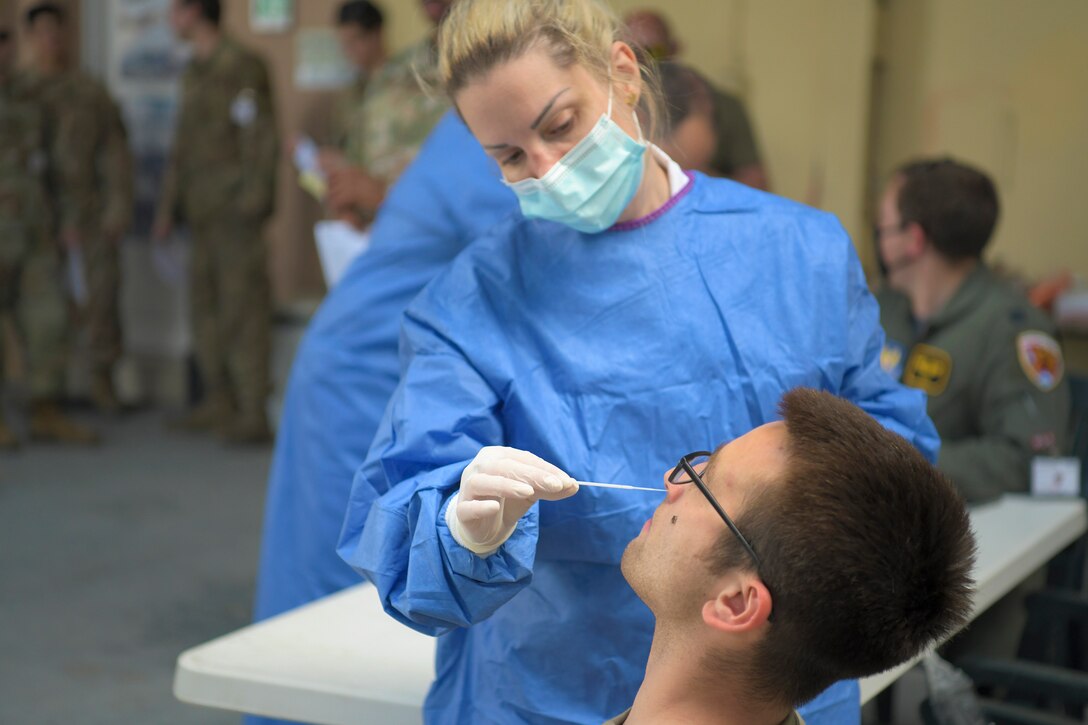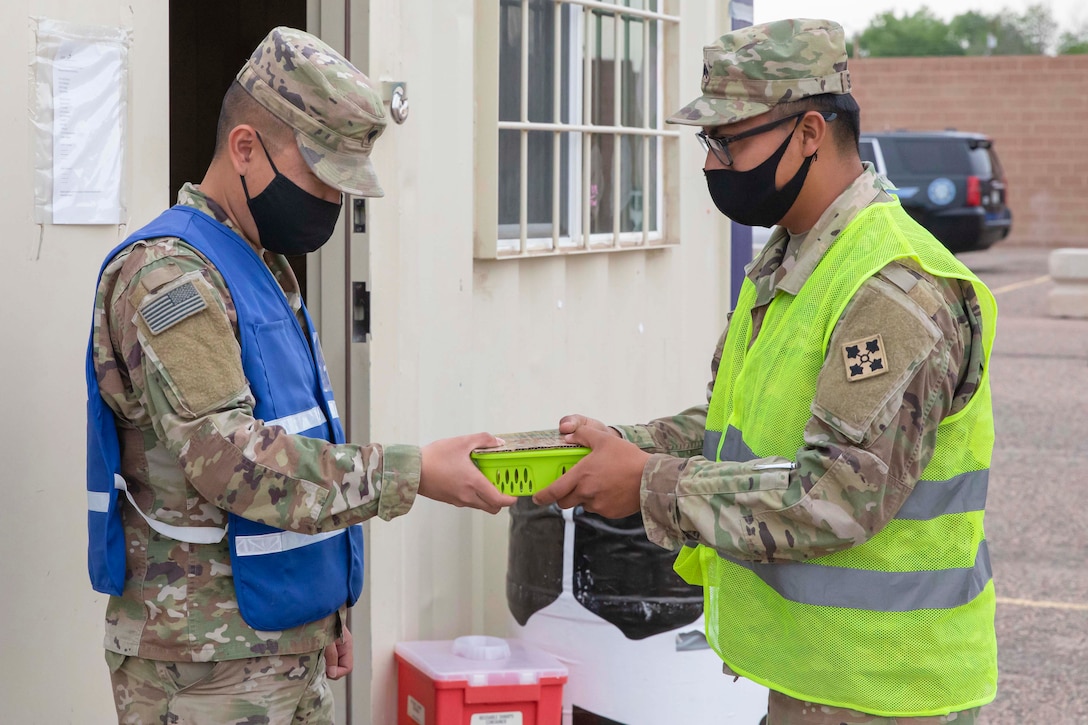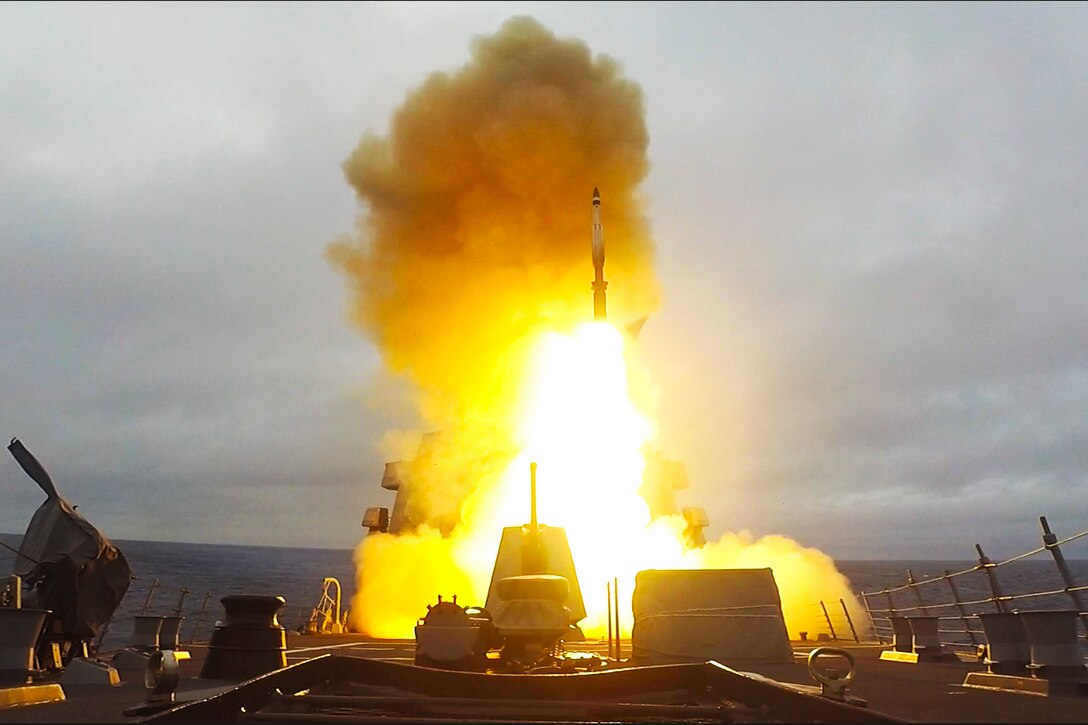The Navy’s Blue Angels in a flyover across the Navy-Marine Stadium, where the 2021 Naval Academy class of midshipmen graduated in person, Annapolis, MD., May 29, 2020.
Friday, May 28, 2021
Flags In
Coast Guardsmen place American flags at headstones in Arlington National Cemetery, Arlington, Va., May 27, 2021. The tradition, known as “Flags In,” is held annually prior to Memorial Day to honor the nation’s fallen veterans.
Flags In
Soldiers assigned to the 3rd U.S. Infantry Regiment, known as “The Old Guard,” place American flags at headstones in Arlington National Cemetery, Arlington, Va., May 27, 2021. The tradition, known as “Flags In,” is held annually prior to Memorial Day to honor the nation’s fallen veterans.
Flags In
A sailor places American flags at headstones in Arlington National Cemetery, Arlington, Va., May 27, 2021. The tradition, known as “Flags In,” is held annually prior to Memorial Day to honor the nation’s fallen veterans.
Deputy Secretary Of Defense Dr. Kathleen Hicks Remarks on President Biden's Fiscal Year 2022 Defense Budget Request
May 28, 2021
STAFF: Hello everyone, happy Friday. Importantly, happy budget day, and thank you all for coming. So first before we begin, I want to thank my colleague, Chris Sherwood, who has been working diligently to make it a success, and certainly it is.
So today as you all know President Biden submitted his fiscal year 2022 budget request to Congress. The request includes $715 billion for the Department of Defense. To speak about these critical investment for the Department, we have a days long schedule of briefers here for you today including, Comptroller and J8. But first, Deputy Secretary of Defense Doctor Kathleen Hicks will join us to provide opening remarks on the vision and key priorities as laid out in the budget.
Now, the Deputy Secretary does have a hard stop after this so we will not be taking questions. However, please do note, that there is ample time devoted at the end of the briefing for questions. So with that, I'd like to welcome Deputy Secretary of Defense Kathleen Hicks.
DEPUTY SECRETARY OF DEFENSE KATHLEEN HICKS: Thank you, Jamaal, and thanks to all of you for being here today. Before providing some brief opening remarks and -- I'll be turning it over to Ms. McAndrew, who I think you know is performing the duties of Under Secretary of Defense for Comptroller and Vice Admiral Boxall, Director of Force Structural Resources and Assessment of the Joint Staff.
I do want to publicly thank Anne, Ron, and their entire team. There are so many moving pieces to this budget as you about to hear over the coming hours. It's an incredible size and scope and they have done an especially skillful job in a difficult environment this year, so thank you to them. As Secretary Austin has stated, he is committed to matching resources to strategy, strategy to policies, and policies to the will of the American people.
President Biden's FY 2022 Defense Budget requests $715 billion does just that. The request is directed by the President's interim national security strategic guidance, and further guided by Secretary Austin's message to the force which lays out three priority areas of the Department. Defend the nation, take care of our people, and succeed through teamwork. To defend the nation, the Department in this budget takes a clear eyed approach to Beijing and provides the investments to prioritize China as our pacing challenge.
The PRC has become increasingly competitive in the Indo-Pacific region and around the world. It has the economic military and technological capability to challenge the international system and American interests within it. It does so along a continuum of conflict, ranging from routine statecraft, to coercive behavior, to the potential for combat operation. Most immediately, defending the nation means defeating COVID-19.
You will see investments that reestablish DOD's important role in pandemic preparedness and health force protection. Defending the nation also means addressing the damaging effects of climate change on our military installations.
Simultaneously, we need to address, excuse me, advanced and persistent threats emanating from Russia, Iran, North Korea and other actors, non-state and transnational included. Of note, this budget reflects the president's decision to withdraw all U.S. forces from Afghanistan by September 11, 2021, and provide over-the-horizon capability for counterterrorism and Afghan National Security Forces support.
As the president's interim guidance makes clear, advancing America's national security interests requires a whole of government approach. Often times, that will mean that the Defense Department serves in a supporting role to diplomatic and economic tools. This puts the United States in the best position to avoid conflict and peacefully advance our interests.
However, to deter aggression, the U.S. military will need to be ready. The FY 2022 requests provides the resources necessary to ensure that DOD maintains that credible deterrent by sustaining readiness and protecting investments in critical capabilities. The budget also documents some of the tough choices we had to make.
We lessened our reliance on vulnerable systems that are no longer suited for today's advanced threat environment or are too costly to sustain. Critically, we reallocate resources to fund research and development in advanced technologies, such as microelectronics. This will provide the foundation for fielding a full range of needed capabilities, such as hypersonic missiles, artificial intelligence, and 5G.
Modernizing also means bolstering our capabilities in cyberspace. This request ensures that the Joint Force maintains the ability to succeed in a contested cyber environment. It provides the resources for the department to defend forward, and continues building cyber resiliency and protecting critical infrastructure.
Deterring Beijing and others who would threaten our security also means leveraging our greatest strategic asymmetry relative to those global competitors, our network of allies and partners. In succeeding through teamwork, the FY 2022 request strengthens our relationship with our friends across the globe. It modernizes our alliances and further promotes interoperability.
More than this, it also strives to ensure that the department is working with all those across the nation who have a role in our national security. That includes focusing investment in American manufacturing and innovation, especially in underrepresented populations and small businesses.
Doing so means that we will not only build back better, but bolster America's national security industrial base. The president's request also ensures that we continue to care for DOD's total force. We have prioritized growing our talent by providing pay raises for both military and civilian personnel. We seek to make investments in the workforce where the department has critical needs.
The request also looks to build an increasingly resilient force, one that recognizes and embraces its diversity as a strength. We also make investments in the military health system and a host of family assistance programs. In assuring accountable leadership in the department, the budget supports sexual assault and harassment prevention.
And while the vast majority of those at DOD serve their country and uphold their oath to the Constitution with honor and integrity, we must be ready to address insider threats and extremism. The budget provides funding to strengthen DOD's ability to identify and address such threats in its ranks.
To ensure that our investments are aligned with our priorities, our FY '22 request has been subjected to a reform process that realigns spending and reduce costs. The majority of these savings were generated by improving business processes, reforming policy and focusing on divestments.
Part of that reform process is ensuring that the department conducts a consolidated financial audit. Now only does audit assist in informing strategy but it provides transparent accountability to the American people.
As directed by the interim guidance, defending America also means setting clear priorities within our defense budget. The president's strategy driven budget requests achieves that goal and positions the Department of Defense to meet the array of security challenges that we face today and in the future.
Thank you for your time today. Ms. McAndrew and Admiral Boxall will be up momentarily. Thank you.
Department of Defense Press Briefing on the President's Fiscal Year 2022 Defense Budget
May 28, 2021
STAFF: Good afternoon and thank you for coming. I'd like to remind everyone that today's briefing is on the Department of Defense's fiscal year '22 budget request. Speaking with you today are performing the duties of Under Secretary of Defense Comptroller Chief Financial Office, Anne McAndrew. And Director of Force Structure, Resources and Assessment with the Joint Staff, Vice Admiral Boxall.
We will have 25 minutes for the budget overview presentation followed by 10 minutes for questions. Attribution is on the record. Prior to asking your question, please state your name and you affiliation. I ask that you limit yourselves to one question and one follow-up question so that everyone has an opportunity in the room and on the phone to ask a question.
I will let you know when we're nearing the end and there's time for one last question. With that it's my pleasure to introduce Ms. Anne McAndrew and Vice Admiral Boxall.
PTDO USD ANNE MCANDREW: Thank you, Chris. Thank you all for coming here today. Vice Admiral Boxall and I will give you an overview of our budget request and then we will take questions after our presentation.
The Fiscal Year '22 defense budget reflects the President's national security values and priorities. It's a strategy-based budget aligned with President's interim national security strategic guidance, which emphasizes the solemn obligation to protect the security of the American people, enduring interests and expanding economic prosperity and opportunity, and a commitment to realizing and defending the democratic values at the heart of the American way of life.
To meet the goals illustrated here, the budget request takes a broader approach to national security to address threats such as climate change, COVID-19 and extremism, makes smart and disciplined choices regarding our national defense, particularly by aligning our resources to evolving threats, and addresses strategic competition with China through calculated defense investments.
Fiscal Year '22 budget is further informed by the Secretary's message to the force, which builds on the interim guidance and outlines the defense priorities. The message to the force has three overarching priorities to drive our Fiscal Year '22 investments. They are defend the nation, take care of our people and succeed through teamwork.
The budget prioritizes the China threat as the department's pacing challenge. We will continue to modernize our forces' global posture and operational concepts to ensure our military is capable of deterring and defending against aggression in the Indopacific that would undermine the security of both the United States and our allies.
The budget also ensures that the department is capable of managing other advanced and persistent threats, including those stemming from Russia, Iran and North Korea, and violent extremist organizations. Addressing the range of threats facing the nation will require the department to work in close partnership with our interagency and international partners.
The budget also invests in innovative technologies that would deliver new warfighting advantages to our forces, including artificial intelligence, hypersonic technology and cyber capabilities, among others. To facilitate our investments in innovation, the budget shifts resources away from older platforms and systems that are ill-suited to the current and future threat environment.
Finally, the budget invests in DOD's greatest advantage - its workforce. Taking care of our people and their physical, mental and emotional health is among the department's highest priorities and DOD's budget invests in the growth and development of our total workforce, both military and civilian.
By investing in America's enduring advantages, including our people, the Fiscal Year '22 budget ensures the department can meet today's challenges and be prepared for future challenges from a position of strength and in support of the administration's agenda to build back better.
The Fiscal Year '22 budget request for the Department of Defense is $715 billion, an increase of 1.6 percent from the Fiscal Year '21 enacted level. The request reflects a shift in resources to match our current priorities.
Specifically, the department's focus on China requires additional investments for the Navy and Air Force, and the reduction for the Army reflects the President's decision to withdraw all U.S. troops from Afghanistan by the beginning of Fiscal Year '22.
We nevertheless retained funds for an over-the-horizon capability outside Afghanistan and to deter Iran. As we prioritize the Indopacific, we must also ensure that the components have sufficient resources to transition out of Afghanistan responsibly.
For the first time since 9/11, the direct war and enduring operations costs are included within the base budget request vice in a separate Overseas Contingency Operations, OCO, request. Overall, these requirements total $42.1 billion, a 22 percent decrease from the Fiscal Year '21 level.
Under our first priority of defending the nation, we will commit to supporting the federal government's efforts to defeat COVID-19 for as long as the pandemic remains a threat. So far, we have made tremendous strides towards defeating the virus. Fiscal Year '22 request includes over $500 million for COVID-19 and pandemic preparedness activities.
Now, to China. To address China's growing influence, this budget focuses on developing the right operational concepts, capabilities and plans to deter and maintain our competitive advantage against China. Specifically, the department leveraged the Pacific Deterrence Initiative, PDI, to highlight investments in support of our efforts while also focusing our resources appropriately.
The budget also addresses the need to confront regional nation-state threats while disrupting transnational and non-state actor threats. To meet these challenges, the department must innovate and modernize at speed and scale.
The budget advances technology in key operational areas while making needed divestments of capabilities no longer optimized for the current or future environment. Finally, the budget makes smart investments in the military resilience for climate change. Climate must remain a national security priority and we will integrate climate concerns into our policy, strategy and partner engagements.
In our shift towards the Indopacific, we are making targeted posture investments in the western Pacific, totaling $5.1 billion in the Pacific Deterrence Initiative. The PDI was established to highlight select DOD investments and activities across the Joint Force that bolster deterrence and maintain our competitive advantage in the Indopacific region.
The PDI is not a separate fund but a subset of the department's budget request for investments is especially important to developing the robust capability required to maintain Pacific deterrence. In addition to what is featured in the PDI, the department's budget includes other critical investments in the Indopacific region for Fiscal Year '22. As this year's - represents the first ever PDI presentation, the department expects modifications to the PDI display in the future budget as we work with Congress to make refinements.
As Secretary Austin and the President have emphasized, we must make climate change a priority. It affects all of us, and the entire federal government and the nation must work together to tackle this present and growing challenge.
Our budget requests $617 million of new investments to make our installations more resilient and the department better prepared to address this vital challenge. We're requesting $263 million to strengthen our installations, $186 million for science and technology investments, $153 million in investments to mitigate the department's climate impacts and capitalize on DOD's buying power, and $15 million for climate contingency and preparedness, to incorporate climate risks into war games, exercises and other planning tools to ensure we understand the impacts of climate change on the missions and are prepared to respond.
Planning for today and into the future is our business and we wouldn't be doing our jobs if we weren't thinking about how climate change affects what we do. We need to ensure DOD facilities and equipment are energy efficient and can operate without disruption.
I will turn it over to, now, Admiral Boxall.
NAVY VICE ADMIRAL RON BOXALL: Thank you, Ms. McAndrew. Good afternoon. Strategic deterrence is foundational to every mission the U.S., our allies and partners execute. Equally important, a strong nuclear deterrent enables U.S. diplomacy, reassures allies, deters adversaries and leads to a peaceful resolution of international disputes.
Today's triad is safe, secure and effective. However, key systems are beyond their original design lives. This budget invests over $27 billion to recapitalize Cold War era systems in all three legs of the nuclear triad. The budget continues Columbia-class ballistic missile submarine production for 2028 delivery. It also funds the ground based strategic deterrent, GBSD, and the B-21 bomber to replace aging ICBMs and bombers in the 2020s.
Ballistic, cruise and hypersonic missile technology proliferation elevates the threat of strategic attack from a growing number of potential adversaries. Our FY ‘22 missile defeat and defense request of $20.4 billion continues to develop a next-generation interceptor to defend the nation from missile attack.
Our budget also strengthens regional missile defense by fielding improved Patriot missiles, developing a new Terminal High Altitude Area Defense -- THAAD -- interceptor, and deploying four U.S. Army Short Range Air Defense battalions in fiscal year 2023.
China and Russia are fielding conventional long-range and hypersonic weapons with the capability to threaten our allies, partners, and U.S. forces from extended standoff ranges. This budget enables $6.6 billion to develop multi-domain long-range fires that will allow U.S. forces to hold their adversaries at risk at operationally relevant ranges.
The FY ‘22 budget will field hypersonic weapons on air, land, and sea platforms. We begin production with the Air-Launched Rapid Response Weapon, or ARRW. And we will deliver this hypersonic missile from an air platform in 2022.
In 2023, the Army will field Long-Range Hypersonic Weapon, LRHW, from land batteries. And in 2025, the Navy will field the conventional prompt strike hypersonic weapon onboard the DDG-1000 warship.
The FY ‘22 budget request also procures and modernizes subsonic offensive missiles, increasing the procurement quantity of the Joint Air-to-Surface Standoff Missile-Extended Range, JASSM-ER, and Long Range Anti-Ship Missile, LRASM.
Finally, we continue to modernize and procure Tomahawk cruise missiles with increased survivability and expanded target sets. Our budget integrates this capable cost-effective weapon into Army and Marine Corps missile batteries beginning in 2023.
Ms. McAndrew will now discuss our investments in science, technology, and advanced capability enablers.
MS. MCANDREW: In order to modernize and innovate and keep up with the revolution in technology that is already underway, the budget makes the largest investment ever in RDT&E, $112 billion, increasing by more than more than 5 percent over the fiscal year '21 requested level, while science and technology increases by 4.1 percent over the fiscal year '21 request.
Guided by a new innovation steering group, the department is addressing ways we can transform, organize, and resource and sustain our technological military edge while best leveraging the U.S. technology and innovation sector.
The request prioritizes technology that we categorize as advanced capability enablers, innovations that vastly increase our military capabilities, in some cases uprooting established technologies in ways that render prior technologies or capabilities obsolete.
There are more advanced capability enablers than we have time to address. But I have highlighted a few here such as microelectronics, artificial intelligence and 5G, in addition to hypersonics capability discussed previously by Admiral Boxall.
ADM. BOXALL: The FY ‘22 budget develops, procures and modernizes air, naval, and ground forces that will project greater power at longer ranges and with higher speed.
First, we invest over $52 billion to develop and field lethal air forces. In tactical aviation we continue to field a mix of fourth- and fifth-generation fighter aircraft by procuring 12 F-15EX fighters, 85 new F-35s, and modernizing the exiting F-35 fleet. The department also invests $1.5 billion to develop next-generation air dominance capabilities. We are also modernizing our mobile air forces by procuring 14 new KC-46 tankers to replace the aging tanker fleet.
The FY ‘22 budget invests $34.6 billion to modernize our naval forces with a balanced fleet of manned and unmanned platforms and maintains a healthy shipbuilding industrial base. The department invests $22.6 billion for shipbuilding to procure 8 battle force ships, including one destroyer, one frigate, two Virginia submarines.
We also invest over $6 billion to develop the future expeditionary Marine force. And with congressional support we will revitalize our sealift fleet by purchasing five used vessels.
Finally, the FY ‘22 budget invests $12.3 billion to provide our soldiers with greater firepower and more reliable systems. The Army is procuring 110 precision-strike missiles that will increase volume and speed of fires. At the soldier level, we are developing next-generation combat vehicles and will deliver next-generation squad weapons to the first units in FY ‘22.
China and Russia are challenging the U.S. advantage in space by fielding weapons to deny or destroy our space capabilities. Lasers, electronic warfare, grappling systems and direct action projectiles are a few technologies our adversaries have fielded or are developing to blind, jam, or destroy U.S. space systems.
The FY ‘22 budget invests $20.6 billion to strengthen U.S. capability in space to deter conflict and prevail in a global all-domain fight. Our budget improves missile warning by investing $2.6 billion to develop the Next-Generation Overhead Persistent Infrared satellite. We also invest $1.8 billion for two GPS follow-on satellites and to harden precision, navigation, and timing signals that will enable GPS-degraded operations.
Finally, the department funds five space-launched vehicles to provide assured access to space and invests in proliferated low-Earth orbit, data transport and missile warning solutions.
As in space, U.S. prosperity and military success depend on defending our networks while defending our networks while holding our adversaries and non-state actors at risk with offensive cyber capability. The SolarWinds event demonstrates the need for robust, modern and ready cyber force.
The FY ‘22 budget requests over $10 billion to improve operations and capability in cyberspace. Our investments improve the technology that will assure next-generation weapons systems are protected from intrusion and attack. We are also embedding zero-trust architectures into defense networks for more selective user credential verification.
We invest in cyberspace operations to improve offensive and defensive cyber effects. Our cyberspace investments will fund four additional cyber mission force teams to hold targets at risk and defend against malicious actors. We are also investing to improve readiness of the nation's cyber forces by funding cyber ranges to enable training and exercises in the cyber domain.
MS. MCANDREW: In order to innovate and modernize at the speed and scale appropriate to meet our challenges, we need to divest from older and less capable platforms and programs. These programs no longer meet our mission and our security needs and we believe these freed-up resources are needed to fund higher-priority programs.
The budget will propose $2.8 billion in divestments, mainly from the decommissioning of ships including the LCS and aircraft such as the A-10. Making the decision to divest from these programs, big or small, was not easy and was not taken lightly. I understand the importance of these programs to many communities across the country. And we will need to partner with Congress to see how we can work together on this.
ADM. BOXALL: We must ensure that the joint force is the best maintained and our service men and women remain the best trained and best equipped in the world. The FY ‘22 budget request of $122.1 billion continues the trend to build military readiness. From ranges to flying hours, the Department is looking at readiness differently then in past years. For example, the budget improves maintenance data analytics and parts availability which will enable military and civilian maintainers to repair ships, aircraft, and brigades in shipyard, hangers, and depots with greater agility.
As discussed by Ms. McAndrew, we will continue to work with Congress to divest legacy platforms that overburden readiness account. Without divestments, we cannot afford to modernize to the evolving threat environment. Last, the budget reflects the President's decision to withdraw from Afghanistan. In addition to fiscal savings, reposturing will enable responsive and flexible global allocation of the joint force.
MS. MCANDREW: In his message to the force, the Secretary identified taking care of our people as one of his top priorities. To do this, the Department is committed to providing a competitive compensation package for those individuals willing to voluntarily serve their country, including a 2.7 percent pay raise for both military and civilian personnel.
This commitment is built into the fiscal year '22 budget request and is demonstrated by the number of initiatives and programs that support professional development and Service members in the family rampant the packet included a $8.6 billion, for about 21 and at that level for family support on that programs that support professional development and to take care of service members and their families.
For instance, the budget includes over $8.6 billion, which is almost 3 percent above the '21 enacted levels for family support and quality of life programs that are important at attracting and maintain a quality force. Also ensuring participation of a diverse workforce requires investment and access to childcare and support to families with dependents with special educational or medical needs. Taking care of our people also means providing a safe environment for our people to work, grow, and advance.
The request includes funds for sexual assault prevention and response, including funding to establish the Defense Center for Excellence for Sexual Assault Prevention, Response, Education, and Training. Another way in which the budget request emphasizes the need to take care of our people relates to the facilities that we provide for our service members, families, and workforce. For facilities, the budget invests nearly $10 billion for military construction and family housing and another $15 billion for facility's restorations, sustainment restoration and modernization.
This growth includes a construction project that was previously deferred to fund border wall project. We will fund those projects that are still needed in fiscal year '21 with the funds that will be returned to the component and the '22 budget also includes almost $700 million to fund those projects that are executable in fiscal year '22. Our facility investment builds on previous budget requests and Congressional investments in environmental cleanup activities and ensures that all executable activity for the remediation of polyfluoroalkyl substances are fully funded in fiscal year '22.
Importantly the budget request reaffirms the Department's commitment to ensuring that both advertised and government and housing is safe, high quality, and well maintained. To that end, the budget continues the same funding of over $50 million higher than the amount requested two years ago. Under the theme of succeeding through teamwork, we've prioritized the rebuilding of our relationships worldwide to ensure that the U.S. maintains a competitive edge.
The Department recognizes that we must work through our allies and partners to advance shared interests, deter key threats, and help allies and partners effectively defend theid sovereignty, based on a foundation of mutual respect and accountability. The budget also supports Build Back Better initiatives here in the United States by investing in critical supply chains, U.S. manufacturing workforce, small businesses and military families. The budget emphasizes this in several ways.
For instance, the budget includes $3.3 billion for the Afghan security forces funds and $3.7 billion for the European deterrence initiatives to name just a few. The DOD understands it can not address the many complex security challenges confronting the U.S. alone.
Congress, other federal agencies, private industry and the American people are all indispensible stakeholders and partners in our efforts to secure the nation's defense.
Personnel and military end strength in particular provide the backbone for all of the department's operations. The department's request for end strength in fiscal '22 is $2.146 million, a slight decrease from fiscal year '21 projected levels. The shift across the services represent the trade-offs made and aligning our end strength with our priorities.
The department end strength is not growing based on the department's shift and focus toward the pace and challenge of China and the Indo-Pacific region. The Navy's reduction is driven by the decommissioning of several ships including four LCSs and an (inaudible).
The Marine Corps is continuing their progression toward their force design 2030. A set of larger reform initiatives aimed at internally generating resources through divestitures.
For the Air Force, the fiscal year '22 decline is driven by decreases to legacy force structure requirements such as C-130H and F-16 modernization as well as a realignment of U.S. Space Force mission transfers.
The Space Force increase reflects the continuing realignment of the Space Force missions from other services. The fiscal year '22 growth is primarily driven by Air Force to Space Force realignments of various national intelligence program personnel.
Next, the next three slides provide additional quantity and funding details on some of our major investments across the department, many of which Admiral Boxall has already touched on. This slide highlights the major investments in nuclear deterrence and missile defeat and defense.
This chart displays the funding and quantities for aircraft and ship building programs. For instance, the aircraft as Admiral Boxall indicated, 85 F-35s which is six more than last year's request. And for ship building the budget requests eight battle force ships in fiscal year '22 the same number as the fiscal year '21 request.
And this chart displays the funding quantities for various space, ground and munitions programs, launch vehicles, global positioning systems enterprise, space based, overhead persistence and fair systems that Admiral Boxall already touched on.
And finally, this is a look at our fiscal year '22 budget request as compared to the fiscal year '21 enacted budget by appropriation title. The budget supports the President's interim national security strategic guidance, follows the Secretary's priorities and promotes security for the nation while meeting the needs of our most important resource, our people.
At this time I'd like to turn it over to Chris. Admiral Boxall and I will welcome your questions.
STAFF: OK, thank you. We'll go over to Lara .
Q: I just wanted to ask about (inaudible) down the funding for Afghanistan this year for us? What exactly is that going to? What is the full number?
MS. MCANDREW: So the Afghanistan funding primarily includes-- the biggest piece is the ASFF which is the Afghan Security Special - Afghan Security Forces Fund. That's about $3.3 billion. It also includes funds for equipment reset, it also includes classified programs. Those are the few that is included in the $8.9 billion for Operation Freedom's Sentinel direct war costs in fiscal year '22.
Q: And so why - why the 3.3 why is that an increase from last year? There was $3 billion in last years from the documents.
MS. MCANDREW: So we believe that given that we are pulling out of Afghanistan we need to provide some additional security support for the ASFF - for the forces there.
STAFF: All right, we're going to go ahead to the phone lines. If I can go over to Tony Bertuca, Inside Defense.
Q: Yes, thank you very much. I wanted to come to the proposed divestitures. Congress traditionally doesn't grant a lot of these and I was wondering what kind of political capital the Secretary of Defense and the Pentagon are prepared to spend to get these divestitures? How important are they and how seriously is the Pentagon taking them?
MS. MCANDREW: On - in order for us to - given the focus on the pacing challenge of China and the other challenge that we have in the department we must divest from our older, less capable, vulnerable, underperforming systems in order to invest in the capabilities that we need most for the future. So the Secretary is -- has indicated that he is - he wants to work with Congress to ensure that we can divest so that we can all - so that we can divest to invest in the future capabilities.
Such as hypersonics, more capable warships, such as the SSNs with (inaudible) module that has the improved deep strike capabilities, just to name a few.
ADM. BOXALL: Yes, if I could just add - I mean if you look at - it's key for us to look at the - we have to spend some money on readiness, we have to spend some money on modernization, we have to spend some money on procurement; finding that balance is really the challenge in almost any budget. As we look forward to the direction - the clear direction in the interim national security strategy clearly that direction is to go to China as it was in the 2018 NDS.
So we look and we say well what are the forces that we've had, what are they doing, and what are the forces we need, what do they look like. And that's really what guided us. So you'll see in here, again, as you talk about going to Congress, we have a lot work to do to ensure that they understand exactly what we're trying to do here. A-10s, for example, we are going to divest a 42 A-10s but also invest in - we keep around 239 A-10s as well. We'll need those in the future to keep capacity but we also need capability.
And some of those we talked about - hypersonics, 5G, A.I. all those types of investments. Everything we - from everything we fail to divest adequately in we have to find those funds in either our ability to operate the force or in how fast we modernize. And we feel that we need to kind of get after modernization and chairman's been very clear on that.
STAFF: OK, we have time for only one more question, please. And over to Steve.
Q: Steve Trimble with Aviation Week. Just to drill down on the Pacific Deterrence Initiative, there's about $400 million added to what INDOPACOM requested, so I was wondering if you could provide the delta of what was changed. And then within the PDI, is there funding -- or, how much funding is -- is there for space-based persistent radar?
MS. MCANDREW: (inaudible)...
ADM. BOXALL: So, well, again, for while she's looking up those numbers, just from a general perspective, I mean, the whole department is kind of shifting its focus on China, and therefore by extension, the -- the Pacific. So trying to figure out exactly how much capability goes specifically to one combatant commander when we're investing in things like joint all-domain command-and-control when we think about, you know, space-based ISR, missile warning, a lot of those other technologies. So you know, how -- that's why this is an initial cut at the PDI. We'll continue to have a dialogue on it.
One of the things, for example, was in there was $118- to figure out what we do about protection on Guam. That was one of the priorities for -- for -- the CENTCOM -- or, the INDOPACOM commander.
So as we look towards trying to solve those challenges, you know, some are global challenges that -- but -- but we did -- do want to kind of highlight those that are specifically in an initiative in the Pacific, kind of like we have an initiative in Europe.
MS. MCANDREW: So on -- since you seem to know, already know, the $400 million is for -- for things within this PDI. They -- they identified $4.8 billion and $3.7- with those. $4.8 billion, I think, and then we funded...
ADM. BOXALL: (inaudible).
MS. MCANDREW: No, I'm talking about for INDOPACOM (inaudible) identified. Yeah, they identified -- the department has resourced $2.6 billion with the $4.8 billion that INDOPACOM identified in their 1251 report that they sent to Congress. So $400- of that is in a PDI.
Q: OK.
MS. MCANDREW: And then -- so, does that answer your question?
STAFF: I'm sorry. We -- we do have a hard stop at this point, and that's -- all the time we have at this time. If you have any further questions, reach out to me. You know where I sit. Anyone online as well, or on the phone, please reach out to me if you have any further questions. Thank you for you time. That ends our briefing. Thank you.
Readout of Secretary of Defense Lloyd J. Austin III's Phone Call With Israeli Minister of Defense Benjamin "Benny" Gantz
May 28, 2021
Pentagon Press Secretary John Kirby provided the following readout:
Secretary of Defense Lloyd J. Austin III spoke this afternoon with Israeli Minister of Defense Benjamin “Benny” Gantz. Secretary Austin reaffirmed the United States’ ironclad support for Israel’s security. He shared the Administration’s support for building on the ceasefire to establish enduring security. Both parties agreed to remain in close coordination on shared defense priorities.
DOD Budget Request Boosts Research, Nuclear Modernization and Includes 2.7% Pay Raise
May 28, 2021 | BY David Vergun , DOD News
The budget totals $752.9 billion. It includes $37.9 billion for the Department of Energy and other agencies. It reflects a 1.6% increase from the fiscal 2021 enacted budget.
The budget provides a 2.7% pay raise for both military and civilians, while investing nearly $9 billion in family support programs.
In a statement today, Secretary of Defense Lloyd J. Austin III said the budget invests in people, supports readiness and modernization, combats threats posed by climate change and provides capabilities needed to meet the pacing threat from Beijing.
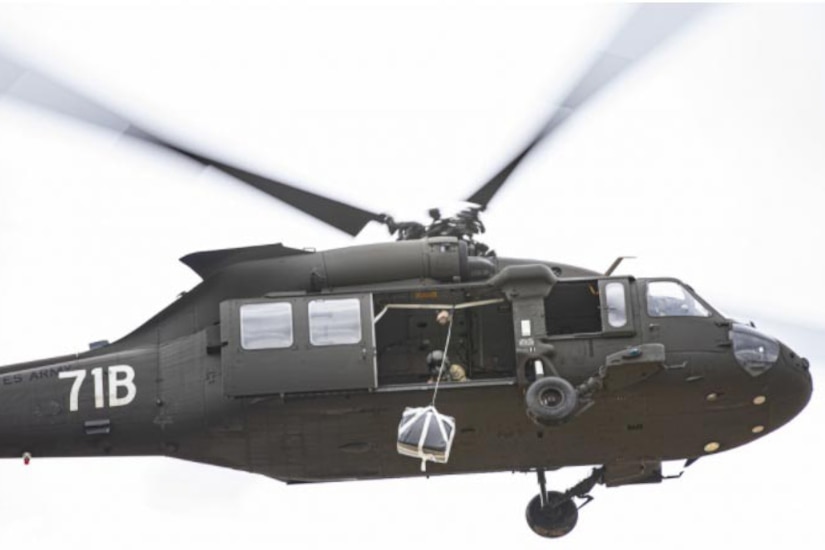
Deputy Secretary of Defense Kathleen H. Hicks briefed the media today on the fiscal 2022 Defense Department budget. She reiterated Austin's comments and said the budget also addresses the COVID-19 pandemic and drawing down U.S. forces from Afghanistan with an exit date of Sept. 11, adding that the department will provide over-the-horizon capability for counterterrorism and Afghan National Security Forces support.
"The budget also documents some of the tough choices we had to make, as we lessen our reliance on vulnerable systems that are no longer suited for today's advanced threat environment, or are too costly to sustain," she said.
Those resource reallocations, she said, are going to fund advanced technologies like microelectronics, hypersonic missiles, artificial intelligence, cyberspace capabilities and a 5G network.
DOD also has invested in its workforce, particularly in billets where there are critical needs, she said. "The request also looks to build an increasingly resilient force, one that recognizes and embraces its diversity as a strength."
The budget also provides funding to strengthen the department's ability to identify and address insider threats in its ranks and to combat sexual assault and harassment, she said.
The budget request slightly lowers total military active and reserve component end strength from FY21 authorized 2,150,375 to 2,145,900. The only service to get an end strength increase is the Space Force, which had 6,434 guardians authorized in FY21, with a request to bump that up to 8,400.

Anne McAndrew, performing the duties of under secretary of defense (comptroller) and chief financial officer, said that the budget also reflects capabilities for managing threats from Russia, Iran, North Korea and violent extremist organizations, in addition to China.
The budget also invests in taking care of people. "Their physical, mental and emotional health is among the department's highest priorities," she said.
Navy Vice Adm. Ron Boxall, the director of Force Structure, Resources and Assessment, Joint Staff, said the department will work with Congress to divest legacy platforms that overburden readiness accounts.
Budget request highlights include:
- $20.4 billion for missile defense
- $6.6 billion to develop and field long-range fires
- $52.4 billion for fourth- and fifth-generation fighter aircraft
- $34.6 billion for a hybrid fleet of manned and unmanned naval platforms
- $12.3 billion for ground force weapons and next generation combat vehicles
- $20.6 billion for space capabilities
- $10.4 billion for cyberspace activities
- $122.1 billion for training, installation support, and support to allies and partners.
Readout of Secretary of Defense Lloyd Austin's Call With NATO Secretary General Jens Stoltenberg
May 28, 2021
Pentagon Press Secretary John F. Kirby provided the following readout:
Secretary of Defense Lloyd J. Austin III spoke by phone with NATO Secretary General Jens Stoltenberg today ahead of the June 1 virtual NATO Defense Ministerial.
Secretary Austin expressed his support for Stoltenberg’s NATO 2030 initiative, which aims to keep the Alliance strong militarily, make it stronger politically, and give it a more global view. Secretary Austin focused on the importance of maintaining a credible NATO deterrence and defense posture, investing in defense capabilities, and improving Alliance readiness to fight and win if deterrence fails. The leaders also discussed the retrograde in Afghanistan and the NATO mission in Iraq.
Secretary General Stoltenberg also highlighted his visit to the HMS Queen Elizabeth where he saw NATO Allies working together as part of the Steadfast Defender 21 exercise.
The virtual Defense Ministerial is the final opportunity for senior NATO defense leaders to consult, coordinate, and decide on Alliance security issues prior to the meeting of NATO Heads of State and Government on June 14.
Test Time
Air Force Senior Airman Kenneth Johnson receives a COVID-19 test during exercise Astral Knight at Larissa Air Base, Greece, May 21, 2021. The exercise enhances the readiness, strength and cohesion between the U.S., Albania, Croatia, Greece, Italy, Slovenia and units from around European Command.
Vaccine Delivery
Army Spc. Young Chen, left, receives a batch of COVID-19 vaccines from Sgt. George Seibert in Pueblo, Colo., May 26, 2021.
Atlantic Launch
The USS Paul Ignatius launches an SM-3 missile in the Atlantic Ocean, May 26, 2021, during At-Sea Demo/Formidable Shield, a live-fire integrated air and missile defense exercise.
Readout of Under Secretary of Defense for Policy Dr. Colin Kahl's Call with Singaporean Permanent Secretary for Defence, Chan Heng Kee
May 28, 2021
Pentagon Deputy Press Secretary Jamal Brown provided the following readout:
Today, Under Secretary of Defense for Policy Dr. Colin Kahl spoke with his Singapore counterpart, Permanent Secretary for Defence Chan Heng Kee. Permanent Secretary Chan congratulated Under Secretary Kahl on his confirmation, and the two leaders reaffirmed their mutual commitment to the U.S.-Singapore bilateral defense relationship.
Under Secretary Kahl and Permanent Secretary Chan Ng discussed COVID-19, and Under Secretary Kahl applauded the strong measures Singapore has taken with its response efforts during the pandemic.
Both leaders exchanged views on the regional security environment, and Under Secretary Kahl stressed the need for a rules-based approach to security challenges in the Indo-Pacific. Under Secretary Kahl expressed appreciation for the regional access Singapore provides to U.S. forces, and both leaders expressed interest in further collaboration on U.S. force posture. Finally, Under Secretary Kahl and Permanent Secretary Chan noted that they look forward to meeting in person.
Readout of Secretary of Defense Lloyd Austin III Meeting With Indian External Affairs Minister Subrahmanyam Jaishankar
May 28, 2021
Pentagon Press Secretary John Kirby provided the following readout:
Secretary of Defense Lloyd J. Austin III met with India’s Minister of
External Affairs, Dr. S. Jaishankar, in Washington, D.C. today to
discuss shared priorities in the U.S.-India strategic partnership and
exchange views on a range of regional security challenges. Secretary
Austin and Minister Jaishankar reaffirmed their commitment to sustaining
a free and open Indo-Pacific region and strengthening the U.S.-India
Major Defense Partnership. They also discussed opportunities to deepen
coordination amid the resurgence of COVID-19 cases. Secretary Austin
conveyed that he looks forward to hosting Minister Jaishankar and Indian
Defense Minister Rajnath Singh at the 2+2 Ministerial Dialogue later
this year.
Sea Trials
Navy Petty Officer 2nd Class Trevor Gilchrist uses a sextant aboard the USS Harry S. Truman during sea trials in the Atlantic Ocean, May 19, 2021.

